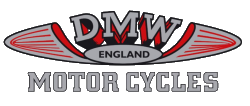

1957 The 99cc 4F engine Bambi scooter appeared, with its monocoque frame that was also the body. The 249cc 2T engine Dolomite road model also arrived.
1958 The 249cc 2T twin engine, used in the Dolomite was fitted to a scrambles model.
1959 A larger, 246cc 32A engine was used for trials and the 33A engine for scrambles models. A 324cc 3T version of the Dolomite was also added.
1960 The Bambi was dropped.
1961 The new 249cc 2T engine Deemster was launched. It combined scooter with motorcycle; weather protection with good handling. The rest of the range continued.
1962 After many improvements to the range, rationalization occurred when DMW took over Ambassador.
1963 A new competition model was launched. This was the Hornet road racer with a 247cc Starmaker engine. Later on, the firm built a 500cc twin using two of these engines, but that was strictly for themselves to run.
1966 The range shrank and the Deemster was built using a 247cc Velocette flat-twin, two-stroke engine, as well as the usual 2T.
1967 Only the Hornet racer and the Highland Trials models, using a Cotton frame and a 37A engine were produced. Although they continued to make parts and the occasional trials machine, the company effectively ceased trading.
Note: Around 1971 they bought the jigs from Villiers to produce spare parts for Villiers engines, and stopped producing their motorcycles and scooters and for a short time during the late 1970s the company produced some Villiers-type 246cc engines. These were supplied to Cotton and Dot, but it was short-lived.
Source:
Graces Guide
If you have further information or a query related to this page, please contact us